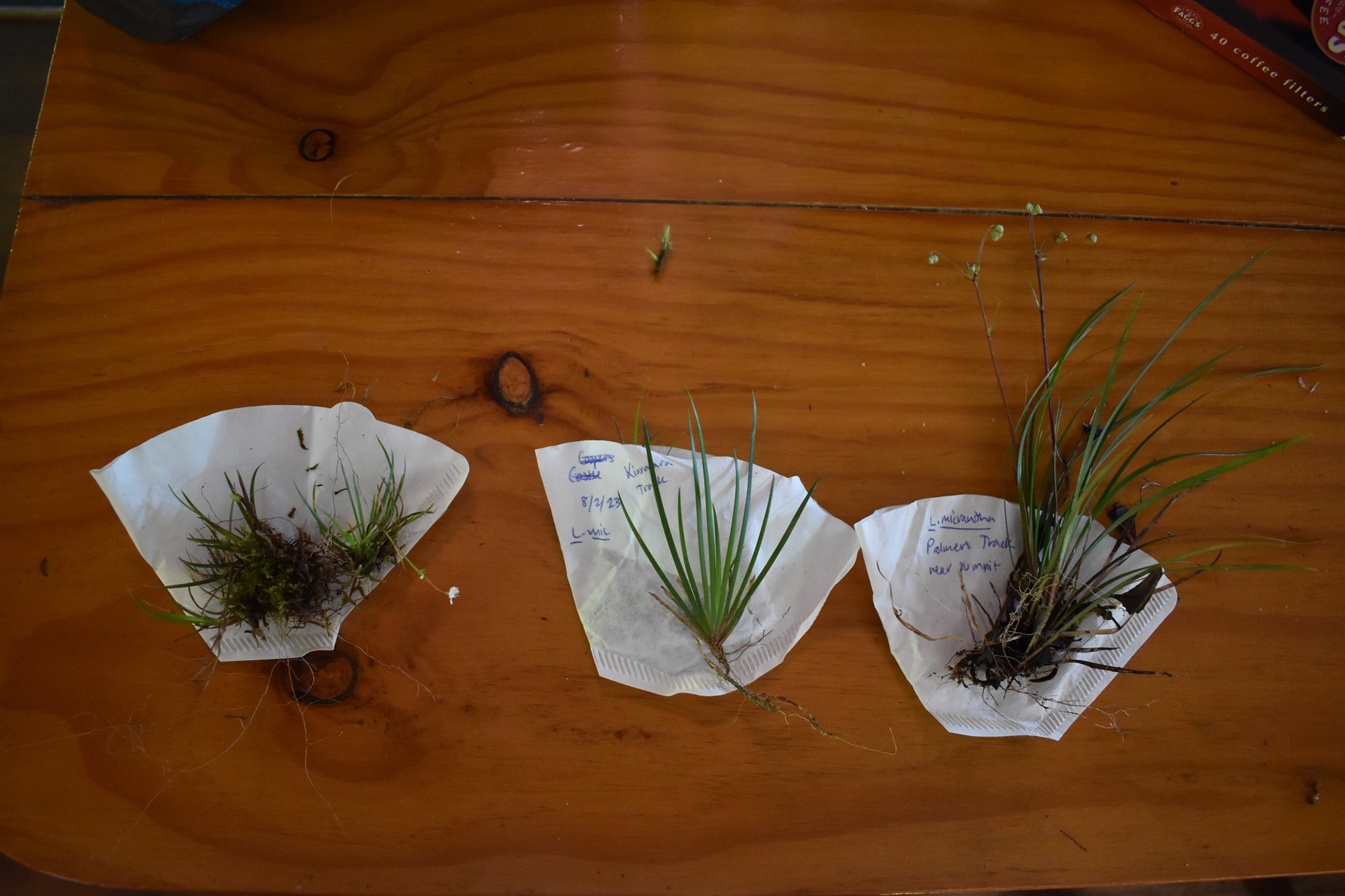Searching for Libertia (Mikoikoi/New Zealand Iris) on Aotea
SOPHIE NEWMARCH (PhD student, Massey University)
The team from left to right, Richard, Sophie, and Barry at the summit of Hirakimatā (Credit: Barry Scott)
When not in flower, species of Libertia, the only iris genus native to New Zealand(1)(2), are hard to spot. In the forest, their green to yellow, flax-like foliage is easily missed amongst the abundant kauri grass (Astelia trinervia) or the seedlings of harakeke/NZ flax (Phormium tenax), tī kōuka/cabbage tree (Cordyline australis) and nikau palm (Rhopalostylis rapsida). The key vegetative features distinguishing Libertia from plants with similar morphology are the fan-like arrangement of the leaves that are flat and smooth. The lack of a leaf crease is due to an interesting feature of irises where the upper surfaces are merged, like a closed book, so that all you see is the underside (‘abaxial’ surface) of their leaves(3). So, the other monocots listed above differ from Libertia as they have leaves which have creases or appear like open books. If you’re in luck, you might spot another clear give-away feature in late summer and autumn; the brown to yellow, balloon-shaped fruits of the larger Libertia species(2).
Sophie and Richard discovering L. grandiflora (mikoikoi) near the stairs by Station Rock lookout (Credit: Barry Scott)
In late summer, well after the white blooms of Libertia would be expected to have finished, three scientists took up the challenge of finding the native irises on Aotea. They included myself, a Plant Biology PhD student at Massey University; Dr. Richard Winkworth, my PhD supervisor; and Emeritus Professor and local Aotea conservationist, Barry Scott. Our purpose was to sample small amounts of leaf tissue for my PhD project that is focused on better understanding the diversity and evolutionary history of Libertia. I would like to find out, for instance, where New Zealand’s irises came from - other Libertia species occur in Australia, New Guinea, and South America(1)(2) - and what the distribution is of their genetic diversity in New Zealand so we can better target conservation actions.
Sampling from Aotea was important as the island is a diversity hotspot, hosting 3 out of 8 of the Libertia species native to New Zealand: both species known as mikoikoi (L. grandiflora and L. ixioides) as well as the small, subalpine species, L. micrantha(2). The Aotea populations are also interesting because they are isolated from mainland populations. All three species also occur across the North Island, with the distribution of L. micrantha extending to the South Island and L. ixioides to both the South and Stewart Islands(2).
On our first day, Barry guided us up the South Fork Track and down the Kaiaraara Track. We located L. micrantha between Mt Heale hut and the summit of Hirakimatā, as well as when descending the steep stairs of the Kaiaraara Track. On the following day we summited a second time, this time climbing Cooper’s Castle and the Kaiaraara Track then down Palmer’s Track and through to Windy Canyon. We found both L. grandiflora and L. ixioides along the Cooper’s Castle Track and L. micrantha in three areas; just before the Cooper’s Castle lookout, alongside the stairs descending from the summit along Palmer’s Track, and in Windy Canyon. Interestingly, L. micrantha differed in size between these sites, the Palmer’s Track plants being relatively large, (~20cm), those on the Cooper’s Castle and Kaiaraara Tracks midrange (~10cm), and those in Windy Canyon dwarfed (~3cm). These differences may reflect environmental factors such as soil depth or light levels, although genetics may also play a role if isolation occurred along the ridgeline. On the third day, we trekked up to Station Rock from Medlands Road, finding L. grandiflora amongst the much drier bush near the lookout and descending towards Rosalie Bay Road.
L. micrantha found between Mt Heale hut and the summit of Hirakimatā, flowering despite the late season (Credit: Sophie Newmarch)
The inflorescence of L. grandiflora that is taller than its leaves (and is the species namesake feature) (Credit: Sophie Newmarch)
The large capsules of L. ixioides on the Cooper’s Castle Track (Credit: Sophie Newmarch)
Despite not having flowers to easily spot Libertia, the fieldwork trip was very successful. All three species were collected; two from multiple locations including ones that had not previously been reported and so were a pleasant surprise to find (e.g., L. grandiflora and L. micrantha on the Cooper’s Castle Track). Our fieldwork took us to several exceptional spots on Aotea, making the trip an unforgettable experience. I cannot thank Barry enough for hosting Richard and myself as well as providing invaluable logistical guidance and knowledge about conservation on Aotea. I hope to provide an update with the results of my study in the not-too-distant future. Mainland samples from the Rodney district and Coromandel have also been collected, so it will be interesting to see if my results suggest dispersal over water and/ or movements across a land bridge between the Coromandel and Aotea. Stay tuned!
The size range of L. micrantha across the ridgelines. Locations were, from left to right, Windy Canyon, Cooper’s Castle lookout, and Palmer’s Track near the summit of Hirakimatā. (Credit: Sophie Newmarch)
Acknowledgements:
A big thank you to the Auckland Botanical Society who funded this fieldwork through the Lucy Cranwell Student Grant for Botanical Research and to my supervisors, Associate Professor Jennifer Tate and Dr Richard Winkworth, for supporting me in extending my project and myself as a researcher. I would also like to thank Barry again for making this fieldwork far more successful and enjoyable.
References:
Goldblatt P, Rodriguez A, Powell M, Davies JT, Manning JC, Van der Bank M, & Savolainen V (2008a). Iridaceae ‘out Australasia’? Phylogeny, biogeography, and divergence time based on plastid DNA sequences. Systematic Botany 33:495- 508.
Blanchon D, Murray B, & Braggins J (2002). A taxonomic revision of Libertia (Iridaceae) in New Zealand. New Zealand Journal of Botany 40:437-456.
Goldblatt P & Manning JC (2008b). The Iris family: natural history & classification, Timber Press.






